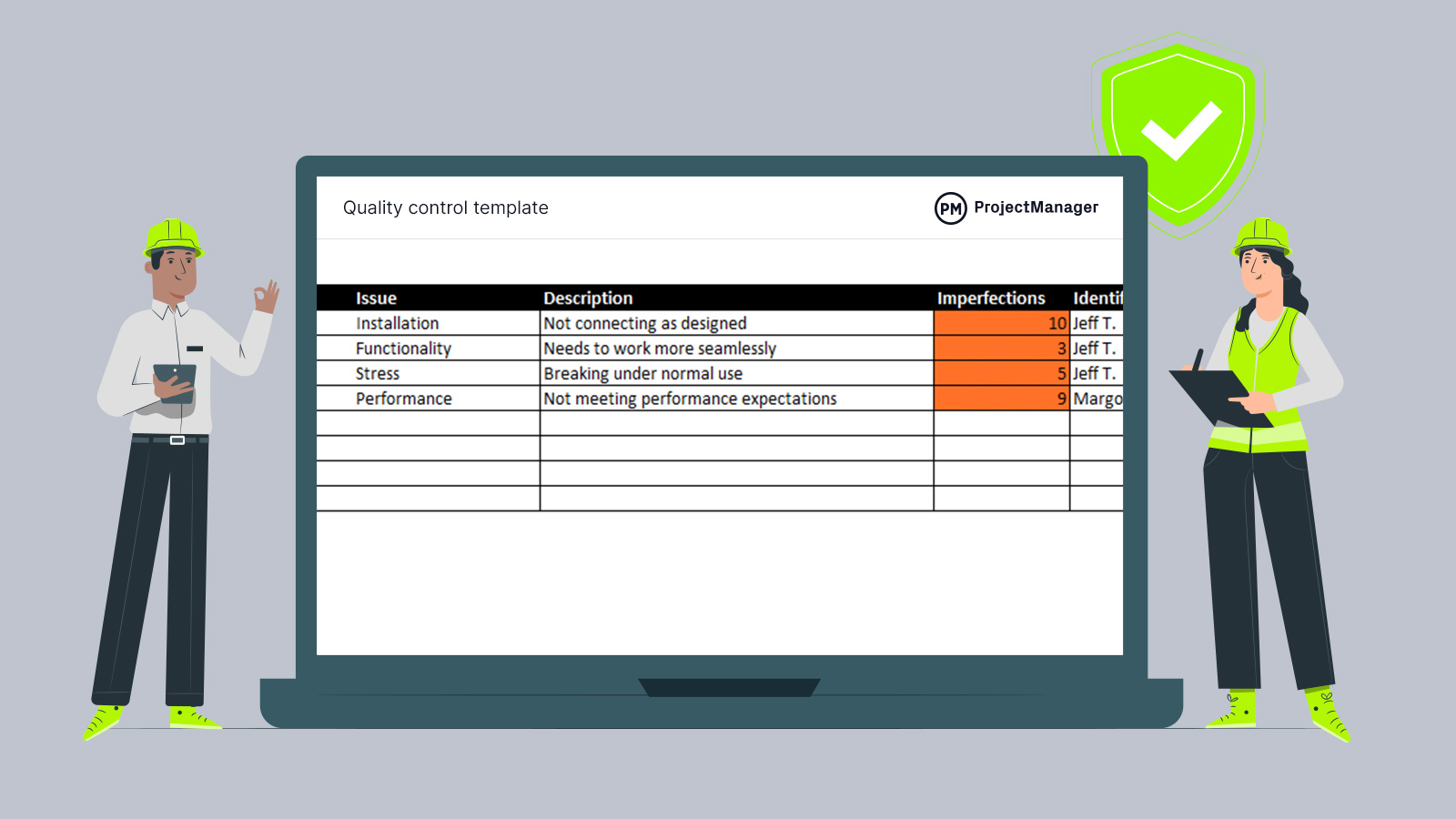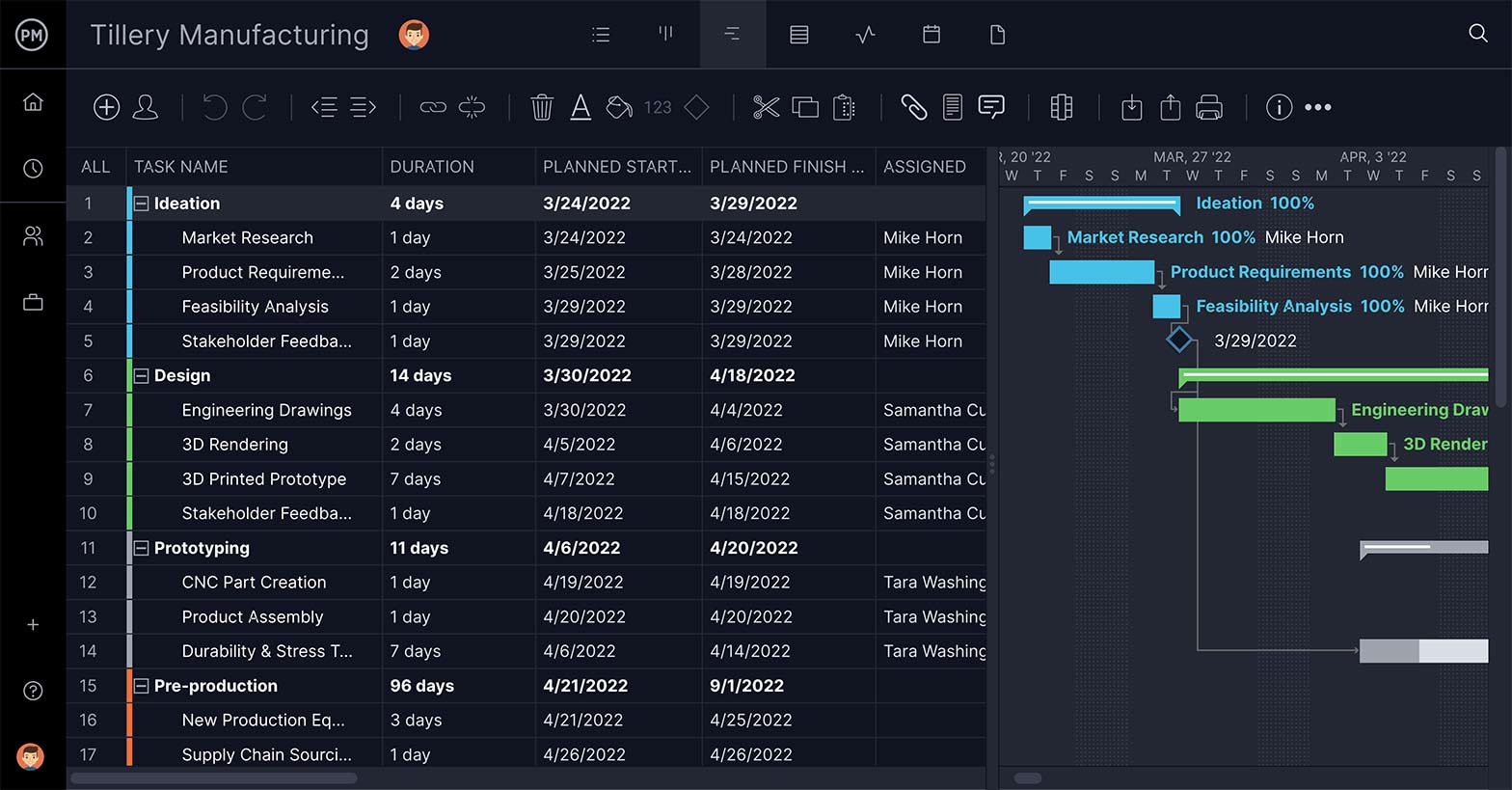Projects are successful when they end on time and within budget. But if you don’t meet the quality expectations of your stakeholders, it doesn’t matter how fast you delivered—you failed.
To avoid this, focus on quality planning. Create a quality plan before you start your project to consistently meet the expectations of your stakeholders.
What Is Quality Planning?
Quality planning is the method of deciding what’s most important to the project. This occurs during the planning stage, where you determine the critical factors for a successful project. This includes the resources needed to deliver the project, what steps to take and specifications that have to be met.
The quality plan itself includes:
- Objectives
- Processes
- Roles and responsibilities
- Applied standards
- Metrics to measure quality
Project management software can save these documents and set milestones in your project plan to make sure you meet benchmarks. ProjectManager’s online Gantt chart can organize your quality planning and measure your progress in real time. Try ProjectManager free today!

Why Is Quality Planning Important?
Quality planning is important because neglecting quality makes it harder to deliver a successful project. Before the execution of the project, the project manager sets the standards to meet in order to qualify the project as a success.
Not only does the project manager define the standards for success, but also the steps necessary to meet those standards. That’s why quality planning is part of the overall project planning phase; it also impacts other areas of the plan, such as costs, scheduling, etc. Without taking this extra step when planning a project, you increase the risk that your stakeholder will not be satisfied with the final deliverable.
A project manager also needs to determine the scope of what will be measured, and the metrics to measure. That quality assurance includes audits, testing, peer review and other measures. All of this requires interviewing stakeholders to understand what their expectations are.

Get your free
Quality Control Template
Use this free Quality Control Template for Excel to manage your projects better.
Who Benefits from Quality Planning?
The short answer is that everyone benefits from quality planning. If you don’t understand and meet stakeholder expectations, they’re not going to be happy—and unhappy stakeholders mean the project has failed. That’s a lot of time, money and effort wasted.
Certainly, stakeholders benefit from quality planning. They’re the ones who are invested in the success of the project. But the project manager and project team also benefit from quality planning, because there’s less reworking, higher productivity and more efficiency when following a quality plan.
Last but not least, the customer or end-user benefits from quality planning. You design your product for the end-user or customer. If they’re not satisfied, you’re not only going to have a failed project on your hands but a tarnished brand.
How to Make a Quality Management Plan
You use a project quality management plan to document all the necessary information to manage the quality of a project. This includes the policies, procedures, criteria, roles and responsibilities. You create it during the planning phase for the project team and stakeholders.
- Determine what is meant by “quality” within the project: This involves discussions with the team to come up with a shared understanding of the acceptable level of quality. Detail this as specifically as possible to avoid confusion during the project. In effect, you create a quality baseline.
- Conduct a gap analysis: Here, you identify the gap between where you are and where you need to be. This leads to the creation of a quality team, which is comprised of people across all departments and levels.
- Define the roles and responsibilities for quality management: These people are accountable for each step in the quality management plan.
- Establish Quality Control Procedures: Once you’ve defined what your quality standards are, you’ll need to establish procedures to measure whether those standards are being met or not, which is known as quality control.
- Create acceptance criteria: This is tied to how you’ll do testing and review. Once you identify weaknesses, brainstorm with your team and integrate the needed quality improvements to your product or service.
Things to Avoid When Quality Planning
Quality planning is an ongoing process. Reviewing and revising the quality plan throughout the project is essential to ensure it remains effective. Sometimes people create a plan and feel as if it’s chiseled in stone, but it’s better to think of it as a dry-erase board.
You might want to make major changes throughout the project. Maybe these changes are necessary, but such big steps are best done in smaller increments. Take small steps that lead to a larger change, as it’ll help see if you’re going in the right direction. If they’re not, it’s easier to fix a small change than a larger one.
Most of all, stay objective. It’s easy to scapegoat an individual and lay the entirety of the blame at their feet. Before you do, step back and look at the whole picture. Having a clear head and putting things in context will let you avoid stigmatizing your team and leads to better overall quality.
Quality Control Template
Once you have a quality management plan, you’re ready to manage the quality of your project. This free quality control template for Excel will help you inspect your products or deliverables and log any quality issues that are found along with other quality control information such as the date when the issue was found, who found the issue, who will be assigned to fix it and the date when the issue is expected to be fixed.

How ProjectManager Can Help With Quality Planning
Quality planning is only the start. You need to execute that planning effectively and monitor the project to catch issues and address them. ProjectManager is cloud-based software that delivers real-time data to help you meet your quality baseline.
Create Quality Plans on Gantt Charts
Before you can monitor your project, you have to have a plan to execute it. ProjectManager’s online Gantt chart helps you schedule the entire project, including quality planning. You can set up quality targets, assign them to your team, which can work together better on our collaborative platform.

Monitor and Track Your Project’s Status
Monitor the project for quality control in real-time with dashboards. Unlike lightweight software that makes the user configure the dashboard, ours are installed and ready to go from the start. You get a high-level view of progress and performance to manage any issues and resolve them before they impact the project.

Create Instant Status Reports for Stakeholders
Stakeholders want to stay informed. ProjectManager’s one-click reporting features let you filter data for a deeper, more targeted look at progress and performance. Generate reports on project and portfolio status, time, costs and more. Then, easily share the reports with stakeholders to keep them in the loop.

ProjectManager is award-winning software that organizes, plans and monitors quality planning. Our robust feature set helps you manage the project from initiation to close while helping teams collaborate no matter where they work. Manage your budget, timeline and resources to deliver on schedule, under budget and meeting quality expectations by trying ProjectManager for free today.

